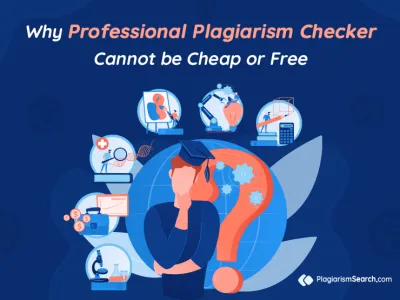
Interesting Plagiarism Statistics
We are living in the age of Internet and technologies. There are tremendous amounts of information and so many tempting opportunities around! Have you seen any plagiarism statistics lately? Aren’t you amazed and terrified with the scope of plagiarism everywhere? It is so easy to start the search and get the results immediately. If everything you want is within touching distance, will many resist the temptation? In most cases, it is so strong that even a prospect of a huge penalty or even suspension cannot make the students apprehensive of a plagiarism checker the school uses. The face of education has changed and nothing can be done to prevent further transformations, especially in the times of COVID-19. Let’s see what is actually happening.
General Info
A survey conducted by Rutgers Business School showed that about 40 % of undergraduate students admitted to borrowing a few sentences here and there. It also found out that 7% of students admitted copy-pasted content without any citation. About the same percentage of students admitted that they borrowed the assignments done by their peers and submitted them to their professors. These are the figures which show how much plagiarism is admitted! In fact, the figures can be quite alarming.
It is essential for the students to know which percentage of copied content is accepted not to cause any issues with the professors. Universities set different guidelines regarding citations and referencing, but the similarity rate of 20 % or higher seems to be excessive in any case. In most cases, less than 15 % is an acceptable percentage although it still means that at least one tenth part of the paper is not original. Obviously, it is not enough to use a free plagiarism checker to ensure that Turnitin, its alternatives, or any other reliable plagiarism detection tool won’t report a high similarity score. One can feel more confident if all sources are properly cited and the work is verified using a trustworthy Turnitin alternative plagiarism checker.
Plagiarism Statistics at the Global Level
Although a lot of Internet users check plagiarism online and know about the consequences of plagiarizing, it is still complicated to get the precise statistics. First of all, not everyone can admit to copy-pasting the sources. Secondly, there are hardly any trustworthy official records of plagiarizers. Thirdly, there are different approaches to plagiarism, and some even believe that there is unintentional plagiarism which cannot be treated as a violation. Still, it is interesting to check the plagiarism situation in the academic world and beyond to see how the problem keeps growing.
- According to the survey of the US News and World Reports, the majority of students (approximately 90 %) truly believe that plagiarizers are caught very occasionally and they are hardly ever disciplined.
- According to the survey results reported by Psychological Record, about 36 % of the undergraduate students honestly admit to one-time or multiple plagiarizing.
- According to the Center for Academic Integrity, college students go far beyond. About 80 percent of them recognize that they have committed the crime of academic cheating.
- According to the survey results reported by Psychological Record, about 36 % of the undergraduate students honestly admit to one-time or multiple plagiarizing.
- According to the Center for Academic Integrity, college students go far beyond. About 80 percent of them recognize that they have committed the crime of academic cheating.
The figures are actually overwhelming. Four-fifth of the college students cannot do without cheating!
Ghoststudying and Plagiarism Stats in the Times of Pandemic
The crisis of COVID-19 has enhanced the plagiarism issues as a result of involuntary distanced learning and social isolation. Classes mostly move online; consequently, the rates of plagiarism jump. There has been a significant increase in the average rate of copy-pasting in academic assignments by 10 percent. Even being aware that universities and colleges use a plagiarism checker that can easily detect the most sophisticated cheating with the written texts, the students cheat even more.
📌 For a deeper look at how plagiarism trends have shifted globally between 2018 and 2024 — including the impact of COVID-19 and the rise of AI tools — see our Global Plagiarism Report.
In fact,
- the rate of plagiarism in the students’ papers has grown from 35 to 45 percent this year;
- the rate of plagiarism has been higher in the documents with greater length (1,000 words or more);
- remote classes and exams have made it much easier to use all kinds of notes and even smartphones with no limitations typical of usual classes. Even the latest plagiarism check software cannot trace such violations;
- in the period from April to August 2020, there was an unseen increase in questions and answers on the section of homework help of Chegg. It made up approximately 200%.
Excuses the Students Have for Cheating
- It was the only time when I actually cheated on my exam. The shift to online classes is not easy for me and I cannot learn properly now because of continuous frustration.
- I plagiarized as I really needed to ask a question and clarify what I found confusing, but the only way to get the answer was to send an email and I gave up. I miss the in-person classes when I could contact the instructor and get an answer with no delay.
- I do not feel that I need to impress my instructors or peers. All I want is just to get the grade and move on. I check for plagiarism free online and do not actually care about the validity of the results.
- It is obvious that most of the students cheat while studying online. Professors actually do not care at all. So, why not make my life a bit easier as well?
Unknown Plagiarism: Things You Were Not Aware About
- Plagiarism goes back centuries.
- There is no term of limitation for fraud and plagiarism.
- Plagiarism scandals can lead to resignations of the top politicians and even cause political changes at the national level.
There is hardly any student not familiar with the term ‘plagiarism.’ They are taking much effort to avoid it as its consequences can be severe. Studying some amazing real-life cases of plagiarizing and getting to know the statistics at the local and national levels can serve as a good method of fighting this problem. Students are not the only plagiarizers, even famous authors, politicians and celebrities take the writings, speeches, posts, lyrics, and images made by someone else. The statistics of plagiarizing is terrifying, and raising the public awareness of the problem can make a valuable contribution into a combat with it.






